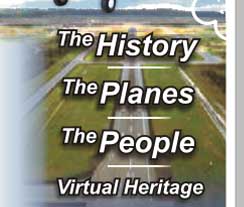 Heritage Community Foundation Presents
Heritage Community Foundation PresentsAlberta Online Encyclopedia
|
|
|
|
|||
 |
|||||
|
|
Home | About Us | Contact Us | Partners | Sitemap |
|
|||
|
|


|
||||
|
Home>>
The History>>
World War I>>
Private Schools |
|||||
|
Private Schools Train Fighter Pilots |
|||||
|
When World War I broke out, aviation was still a very new
invention and few in military planning circles saw its
potential as a useful weapon. The early years of the war were a time of
experimentation, with two air services on which Canadian pilots
could serve. The first was the Royal Naval Air Service (RNAS),
and the second was the Royal Flying Corps (RFC). To be a
military pilot, one had to first have basic flight training and
then sign up through the traditional services like the army or
navy before finally transferring into one of the air services.
To receive basic training, Canadians often travelled to the United States to enter schools like the Stinson School in San Antonio. To fulfil the need for trained pilots, efforts to establish private schools began. The well-known flying pioneer, William (Billy) M. Stark, initiated such a school in Vancouver, British Columbia. While his effort was not practical, it was significant. In the summer of 1915, Stark and a small group of businessmen in Vancouver agreed to form a flying school for the war effort, and made an application to the Fédération Aéronautique Internationale in France. They received certification for the school and named it the Aero Club of British Columbia. The Aero Club raised $2,500 by a public subscription to pay Stark a fee of $25 a week and to attain an aircraft. The school operated on the racetrack on Lulu Island. It had a single seat airplane that Billy Stark took the wings off of so that students could taxi the aircraft with Stark standing beside them, yelling out instructions. Stark placed a wedge of wood under the foot throttle that allowed the students to attain only limited speed. As they progressed, Stark would cut away more wood, permitting them to go faster. Two students graduated in November and entered the Royal Flying Corps. As the winter months came, Stark converted the aircraft to a hydroplane with pontoons, and continued the taxiing exercises at Burrard Inlet. Training ended when the pontoon hit a log and Stark and the students were thrown into the water. The aircraft was destroyed. A new aircraft and organization were needed to continue the training in British Columbia. The Aero Club was dissolved and a new organization called the British Columbia Aviation School Limited was formed. The hope was to raise $15,000 to expand and buy four larger aircraft. However, the funds for such an ambitious plan were not raised, and only one two-seat Curtiss tractor biplane was bought. Several more pilots graduated, but the biplane crashed at Pitt Meadows and the training effort came to a close. In total, 15 students graduated.
|
|||||
|
|
|||||
|
|
Copyright © 2004 Heritage Community Foundation All Rights Reserved |
|
|||
 |
|||||
For more on aviation in Alberta, visit Peel’s Prairie Provinces.


